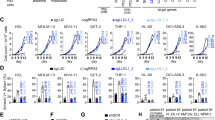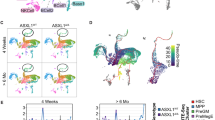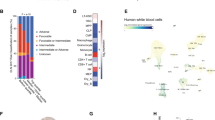Abstract
Acute myelogenous leukemia (AML) is the most common leukemia in adults with clonal proliferation of myeloid stem cells. Two or more cooperating mechanisms, namely block in differentiation, enhanced proliferation and resistance to programmed cell death, underlie this neoplastic transformation. Nonrandom, complete and partial deletions of chromosome 5 are common anomalies in AML. Using positional cloning strategies, we characterized an evolutionarily conserved candidate myeloid leukemia suppressor gene encoding sequence-specific single-stranded DNA binding protein 2 (SSBP2) from chromosome 5q13.3, a locus that is frequently deleted in AML. Recent studies in Drosophila and Xenopus demonstrate a pivotal role for SSBPs in embryonic differentiation. In mammals, SSBP2 is one of three highly related and ubiquitously expressed genes. Here, we identify frequent loss of SSBP2 protein expression in human AML cell lines using highly specific antibodies. Furthermore, inducible expression of SSBP2 in the AML cell line U937 leads to loss of clonogenicity, G1 arrest and partial differentiation. Remarkably, inducible expression of SSBP2 is accompanied by downregulation of C-MYC expression. Our findings are consistent with human SSBP2 being a novel regulator of hematopoietic growth and differentiation, whose loss confers a block in differentiation advantage to myeloid leukemic cells.
This is a preview of subscription content, access via your institution
Access options
Subscribe to this journal
Receive 50 print issues and online access
$259.00 per year
only $5.18 per issue
Buy this article
- Purchase on Springer Link
- Instant access to full article PDF
Prices may be subject to local taxes which are calculated during checkout







Similar content being viewed by others
References
Bayarsaihan D, Soto RJ and Lukens LN . (1998). Biochem. J., 331, 447–452.
Bi S, Hughes T, Bungey J, Chase A, de Fabritiis P and Goldman JM . (1992). Leukemia, 6, 839–842.
Boer J, Bonten-Surtel J and Grosveld G . (1998). Mol. Cell. Biol., 18, 1236–1247.
Bromleigh VC and Freedman LP . (2000). Genes Dev., 14, 2581–2586.
Burel SA, Harakawa N, Zhou L, Pabst T, Tenen DG and Zhang DE . (2001). Mol. Cell. Biol., 21, 5577–5590.
Cantor AB and Orkin SH . (2001). Curr. Opin. Genet. Dev., 11, 513–519.
Caslini C, Shilatifard A, Yang L and Hess JL . (2000). Proc. Natl. Acad. Sci. USA, 97, 2797–2802.
Castro PD, Liang JC and Nagarajan L . (2000). Blood, 95, 2138–2143.
Castro PD, Liang H, Liang JC and Nagarajan L . (2002). Genomics, 80, 78–85.
Chen L, Segal D, Hukriede NA, Podtelejnikov AV, Bayarsaihan D, Kennison JA, Ogryzko VV, Dawid IB and Westphal H . (2002). Proc. Natl. Acad. Sci. USA, 99, 14320–14325.
Dong WF, Heng HH, Lowsky R, Xu Y, DeCoteau JF, Shi XM, Tsui LC and Minden MD . (1997). DNA Cell Biol., 16, 671–678.
Emes RD and Ponting CP . (2001). Hum. Mol. Genet., 10, 2813–2820.
Fleckenstein DS, Uphoff CC, Drexler HG and Quentmeier H . (2002). Leukemia Res., 26, 207–214.
Grand CL, Powell TJ, Nagle RB, Bearss DJ, Tye D, Gleason-Guzman M and Hurley LH . (2004). Proc. Natl. Acad. Sci. USA, 101, 6140–6145.
Hu Q and Maity SN . (2000). J. Biol. Chem., 275, 4435–4444.
McConnell MJ, Chevallier N, Berkofsky-Fessler W, Giltnane JM, Malani RB, Staudt LM and Licht JD . (2003). Mol. Cell. Biol., 23, 9375–9388.
Qian Z, Fernald AA, Godley LA, Larson RA and Le Beau MM . (2002). Proc. Natl. Acad. Sci. USA, 99, 14925–14930.
Rizzo MG, Zepparoni A, Cristofanelli B, Scardigli R, Crescenzi M, Blandino G, Giuliacci S, Ferrari S, Soddu S and Sacchi A . (1998). Br. J. Cancer, 77, 1429–1438.
Suzuki H, Fukunishi Y, Kagawa I, Saito R, Oda H, Endo T, Kondo S, Bono H, Okazaki Y and Hayashizaki Y . (2001). Genome Res., 10, 1758–1765.
Tenen DG . (2003). Nat. Rev. Cancer, 3, 89–101.
van Meyel DJ, Thomas JB and Agulnick AD . (2003). Development, 130, 1915–1925.
Wadman IA, Osada H, Grutz GG, Agulnick AD, Westphal H, Forster A and Rabbitts TH . (1997). EMBO J., 16, 3145–3157.
Xu Z, Huang S, Chang LS, Agulnick AD and Brandt SJ . (2003). Mol. Cell. Biol., 23, 7585–7599.
Acknowledgements
We gratefully acknowledge support from the National Institutes of Health (HL074449). The automated DNA sequencing, peptide synthesis and fluorescence-activated cell sorter facilities are supported by core grant CA16672 to the University of Texas MD Anderson Cancer Center. We thank Dr H Radomska for helpful hints on isolation of stable clones. We thank Dr Helen Fleisig for advice with artwork and Elva Lopez for editorial assistance.
Author information
Authors and Affiliations
Corresponding author
Rights and permissions
About this article
Cite this article
Liang, H., Samanta, S. & Nagarajan, L. SSBP2, a candidate tumor suppressor gene, induces growth arrest and differentiation of myeloid leukemia cells. Oncogene 24, 2625–2634 (2005). https://doi.org/10.1038/sj.onc.1208167
Received:
Revised:
Accepted:
Published:
Issue Date:
DOI: https://doi.org/10.1038/sj.onc.1208167
Keywords
This article is cited by
-
Integrated decoding hematopoiesis and leukemogenesis using single-cell sequencing and its medical implication
Cell Discovery (2021)
-
A set of molecular markers predicts chemosensitivity to Mitomycin-C following cytoreductive surgery and hyperthermic intraperitoneal chemotherapy for colorectal peritoneal metastasis
Scientific Reports (2019)
-
Single-stranded DNA binding protein 2 expression is associated with patient survival in hepatocellular carcinoma
BMC Cancer (2018)
-
Types of DNA methylation status of the interspersed repetitive sequences for LINE-1, Alu, HERV-E and HERV-K in the neutrophils from systemic lupus erythematosus patients and healthy controls
Journal of Human Genetics (2014)
-
SSBP2 is an in vivo tumor suppressor and regulator of LDB1 stability
Oncogene (2010)



